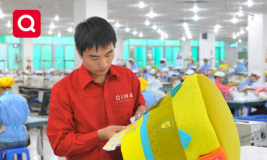Beyond “Safe Enough”: The Importance of Lead Testing in Children’s Toys
The United States banned lead in children’s products back in 1978. Unfortunately, much of the manufacturing world has failed to catch up with this most critical of safety measures. Without proper checks on foreign factory chains, it is all too possible for lead-heavy children’s toys to sneak into homes, introducing lead into children’s bodies via paints and plastics.
Lead has been a known as a possible carcinogen for decades now. Developing children are at a particularly acute risk of lead-related illnesses because of lead absorption through the skin and ingestion because of frequent hand-to-mouth activities. Children can absorb up to 50% of the lead they ingest, spurring ill-health and lifelong developmental disorders.
Lead in Children’s Toys is Never a Thing of the Past
Today’s parents are much better informed about protecting their children from antique toys containing lead and a number of other elements now considered hazardous enough to incur rigorous testing, national restrictions and outright bans of usage in consumer products.
However, that same understanding about the dangers of “old production ways” might blind a parent or caregiver to the reality that today’s toys, unchecked, very well may include a number of hazardous substances such as lead and cadmium. It is a fallacy to assume that new toys have been thoroughly tested before they enter the market--even in the strictest of nations.
Just last year, the U.S. Public Interest Research Group (PIRG) released their 32nd “Trouble in Toyland” report, highlighting four of the most pressing toy hazards of 2017. One of them was excessive lead counts in one of the world’s most popular toys: fidget spinners.
In this particular case, the issue wasn’t whether or not the product contained an excessive level of lead measured against the CPSC’s 100 parts per million (ppm) limit in children’s products--although the numbers found were far higher, over 30,000 ppm in extreme cases.
The issue was what U.S. PIRG and a growing number of like-minded consumer groups saw as a dishonest and potentially dangerous technicality. Because fidget spinners are marketed for “Ages 14+”, they are not considered “Children’s Toys” and therefore not held subject to the 100 ppm restriction.
Further red flags came when high-profile department stores--particularly Target--began stocking fidget spinners in the toy sections meant for children as young as six. After enough media pressure was applied, Target agreed to remove them.
Toy Safety Testing for Realistic Situations
The underlying responsibility of all children’s product manufacturers and importers is safe interaction between the product and the child. Age appropriateness analysis is an important step in the product development process, but the reality is that once a toy is sold and in the world, it will often find its way into the hands of smaller children who will proceed to explore the toy using every sense.
Therefore, the most effective testing strategy begins at the design level, when every possible usage scenario can be considered and a valid safety test can be assigned.
The right Quality Assurance, Lab Testing and Inspection Service can help you consider your design from every realistic perspective and coordinate a testing strategy that will adequately measure the true safety of your toy, including all national and international standards regarding the restriction of unsafe substances like lead or phthalates.
QIMA checks these assurance boxes and can further assist with accurate, detailed factory inspections to ensure that your supply chain does not fall short of your standards. Because a number of countries around the world have yet to implement hazardous element restrictions on toy products, it is realistic to assume that those countries’ factories would not hesitate to add lead to paints and plastics without considering the hazards.
On the other hand, for a growing number of major markets, safety requirements for children’s products are becoming increasingly rigorous as new safety concerns over chemical content come to light.
QIMA believes that your toy company understands what’s required, and that you still want to go further: beyond “safe enough” and to the safest product possible for everyone.
Easily Schedule Your Toy Tests Online
Our online platform and mobile application make it easy for you to schedule Toys and Recreational Item testing, and receive your results at any time. Book new tests, view pending orders, and access results from your mobile device. Our online platform provides valuable supply chain insights, including a summary of your QC activity, all of your supplier’s quality stats, industry benchmarking data, and more.
Get Started: Login or Create Your Account

 Xem Demo
Xem Demo
